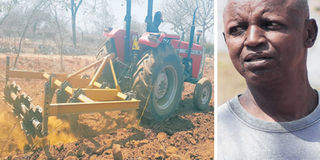New way of tilling land puts the money into semi-arid farmers’ pockets

A tractor rips in Kituku Musai's (left) farm in Makueni for planting. Musai has been using the technology for the last two years and he reckons that it has boosted his yields. PHOTOS | RACHEL KIBUI | NATION MEDIA GROUP
What you need to know:
- Musai, a retired Inspector of Police, has been using the technology for the last two years and he reckons that it has boosted his yields.
- Minimal soil disturbance is achieved by ‘digging’ only the section that is planted. This digging ensures breakage of the hardpan on the soil, which forms over time.
- Johnson Gachuhi, an agricultural officer in Makueni, adding a minor crop is planted between the trenches acting as a cover crop.
- While the ‘normal’ ploughing is charged at Sh2,000 per acre, Musai pays Sh1,800 for the acre.
Kituku Musai looks keenly as a tractor moves with great ease from one end of his farm in Kiunduni, Makueni, to another.
However, while one expects the equipment attached to the tractor to cut through the soil as is usually the norm, on Musai’s farm the opposite is evident as the 67-year-old prepares to grow new crops during the October short rains.
The machine is digging three shallow trenches for each trip it makes on the one acre. The technology known as ripping involves digging trenches for seed planting without turning up the entire soil.
One then plants in the trenches and uses herbicides to control weeds. Alternatively, they can use a ripper to scratch the top surface of the ground while destroying weeds.
Musai, a retired Inspector of Police, has been using the technology for the last two years and he reckons that it has boosted his yields.
From the acre he used to harvest at most two 90kg bags of green grams while using an oxen to plough it.
But he now harvests an average of six 90kg bags of the same produce.
The technology operates under three principles namely minimum soil disturbance, soil cover and crop rotation.
Minimal soil disturbance is achieved by ‘digging’ only the section that is planted. This digging ensures breakage of the hardpan on the soil, which forms over time.
The hardpan, also known as ouklip, is a dense layer of soil, usually found below the uppermost topsoil layer.
RIPPING IS REMEDY TO THE CHALLENGE
“The ripper digs about one-foot deep trenches where the main crop, in this case green grams, are planted. Since the hardpan in the gap between the trenches is not broken, water perforates through, and to beneath the section,” explains Johnson Gachuhi, an agricultural officer in Makueni, adding a minor crop is planted between the trenches acting as a cover crop.
Therefore, the roots of crops planted in the trenches are able to reach the moisture as they run deep. Meanwhile, the cover crop, in Musai’s case cowpeas, prevents evaporation of water leading to high yields.
Gachuhi says tractors and oxen step on wet ground, which hardens over the years to make the hardpan. The third principle, which is keeping off pests and diseases, is achieved through crop rotation as the two attack different crops.
Micheal Waweru, a maize and food crops specialist at USAID-Kenya Agricultural Value Chain Enterprises (KAVES), says soils in the area, as many others which are arid, have developed a hardpan making it impossible for roots to penetrate the soil hence ripping is the remedy to the challenge.
While the ‘normal’ ploughing is charged at Sh2,000 per acre, Musai pays Sh1,800 for the acre.
Some farmers are still hesitant to adopt the technology as they are required to weed twice, while in the older method, one weeds once.





